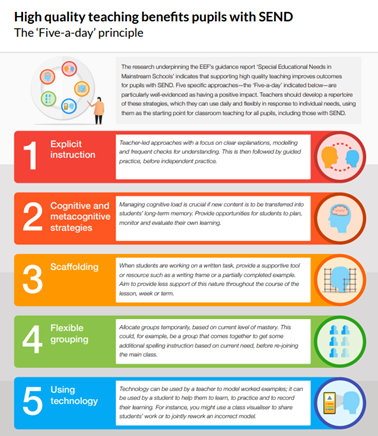Strong Foundations in Writing

'Curriculums are often overloaded with activities that do not focus on helping children to build fluency in foundational knowledge and skills' (GOV.UK, October 2024)
I doubt any educator would question that ‘high quality education establishes the foundations for later success.’
However, Strong foundations in the first years of school - GOV.UK examined how schools secure the foundational knowledge children need by the end of KS1 to give them the best chance of educational success and found that some schools fall short of achieving this:
‘Children who begin school with the lowest starting points and those who start to fall behind are most affected by weaknesses in curriculum, teaching and assessment.’
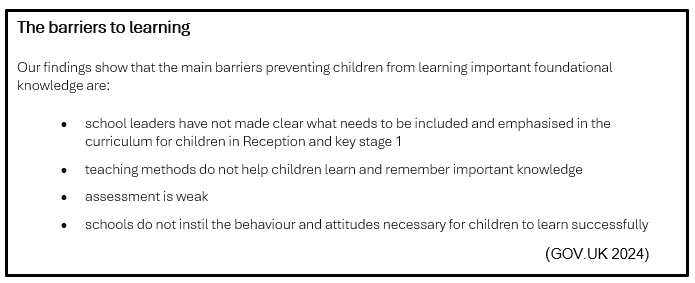
The English report, Telling the Story, also noted that curriculums for writing often introduce complex tasks too early, before pupils have learned the knowledge and skills they need to complete them; fluency in transcription frees up working memory to focus on composing writing.
In terms of writing, the foundational knowledge and skills are:
- Orally compose (and then write) simple sentences
- How to spell
- How to form letters correctly
- How to hold a pencil correctly

How can we ensure children develop fluency in the foundational knowledge and skills of writing?
Firstly, schools need a very clear writing curriculum plan which consistently focuses on ‘What do we want our children to learn?’ rather than ‘What do we want our children to do?’
In addition, staff need to be well-trained in the developmental stages of writing as well as specific phonic, spelling and handwriting programmes. Assessment needs to be effective and acted upon.
Pedagogical choices also need to be appropriate and effective:
- Language is the bedrock of thinking and learning and so needs to be high priority – in order to write, children need to be able to orally compose sentences. Think it, Say it, Write it, Check it!
- Enough time needs be given for skills to be taught and practised until children are fluent
- Tasks should be broken down into small steps
- Appropriate teaching methods need to be selected e.g. use dictation as a way for children to practise spelling without having to compose sentences themselves
- Cognitive load needs to be reduced by having familiar lesson structures and routines
- Explicit instruction must include all children, including those who find learning more difficult
- Children’s starting points must be taken into account and adjustments made to the curriculum to take account of any difficulties
Whilst having a very comprehensive phonics, spelling, handwriting and oracy programme is vital, it is not intended that transcriptional skills be taught in isolation, away from the craft of meaning making and sharing. Nor should transcription be somehow ‘mastered’ before children are invited to develop the other social and cognitive aspects of being a writer. In many schools, the wider writing curriculum is text-driven and in such cases the text type should be used as a vehicle for writing, allowing further opportunities to secure fluency in foundational skills.
‘As pupils developed proficiency in writing captions and simple sentences, leaders took a stepped approach to introducing them to different types of sentence structures and grammatical conventions. Pupils were given time to practise these before starting to experiment with further structures. Teachers modelled the component parts, first at word, then sentence, then paragraph level, before moving on to whole text composition later.’ (Strong foundations in the first years of school - GOV.UK)
When teaching a writing session (composition), regardless of text type, think:

Once the above has been considered, decide what adaptations may be needed for children in order to meet their needs and enable them to practice fundamental skills. The EEF Five-a-day-poster is a useful document to support this process.
When considering adaptations, many scaffolds and resources may be ordinarily available within the classroom (e.g. talking postcards, pencil grips, word mats, magnetic letters etc.) whilst others may be more bespoke (e.g. sentence stems, specific writing paper).
Below are examples of how a well-loved picture book (Owl Babies) can be used in Early Years as a hook into writing and adapted for different children so they can practise the fundamental skills of spelling and handwriting. In these examples, the children were asked to complete a speech bubble for a character.
Child 1
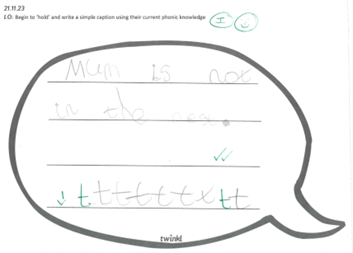 The child can write simple sentences using phase 2 words but finds it hard to remember what they are writing.
The child can write simple sentences using phase 2 words but finds it hard to remember what they are writing.
Provision
- Hold and write a pre-planned sentence so the child can successfully write it
- Oral rehearsal the sentence – you could use pencil as microphone!
- Talking postcard to support ‘holding’ a sentence
- Finger spacer if needed
Child 2
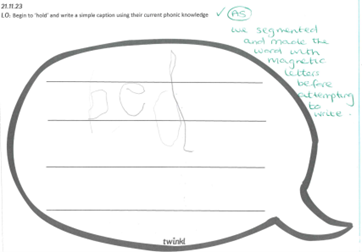 The child can segment words with some adult modelling. They find forming letters more challenging.
The child can segment words with some adult modelling. They find forming letters more challenging.
This child is working at word level rather than sentence level in terms of writing.
Provision
- Segment and write a word rather than a sentence
- Adult support to segment
- Use magnetic letters to build the segmented word
- Adult to model letter formation and child to practice
- Pencil grip
Another example, this time based on an innovation of The Gigantic Turnip, shows how a well-loved picture book can be used as a hook into writing and adapted for different children so they can practise the fundamental skills of spelling, handwriting and sentence composition.
Child 1
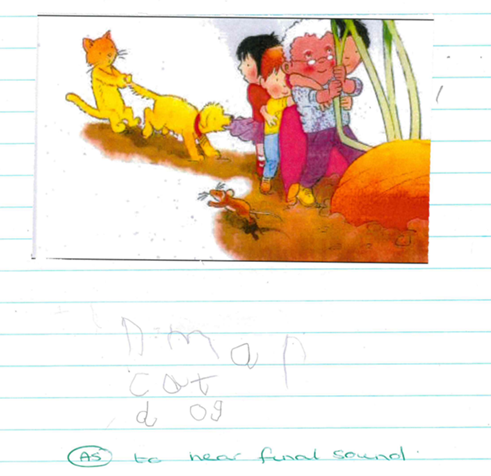 The child can form recognisable letters but is not able to segment simple words.
The child can form recognisable letters but is not able to segment simple words.
The child is working at word level.
Provision
- Orally segment the word with adult modelling/supporting
- Use a grapheme mat to support recognition and formation of graphemes
Child 2
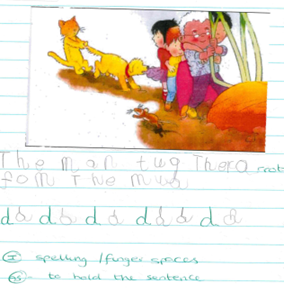 The child can segment and spell CVC words and can form most letters correctly.
The child can segment and spell CVC words and can form most letters correctly.
They need support to compose and remember a sentence.
Provision
- Hold and write a pre-planned sentence so the child can successfully write it OR adult support to orally compose a simple sentence
- Oral rehearsal of the sentence – you could use pencil as microphone!
- Talking postcard to support ‘holding’ a sentence
What children learn when they are young has a profound and lasting impact. This means that schools need to ensure that they have a clear curriculum which enables children to develop fluency in the foundational skills to ensure all children can fulfil their potential and have the best life chances.
Want to know more?
Written by Caroline Dolby, Katherine Semar Infant School
Read our other blog posts here.

